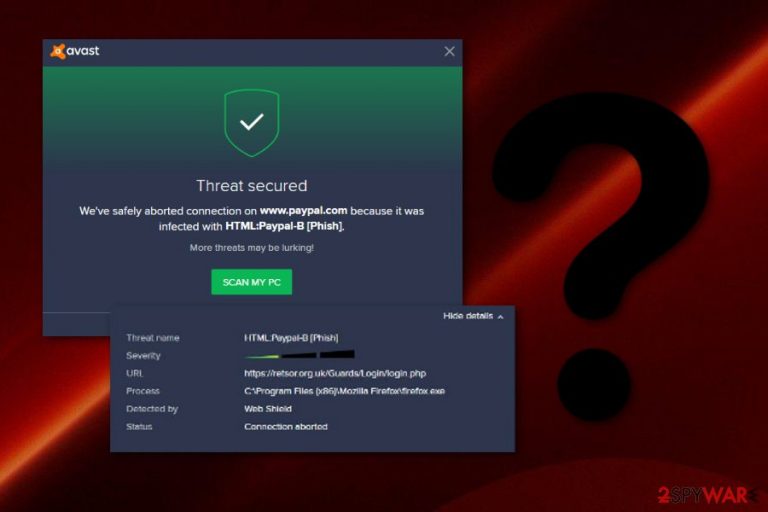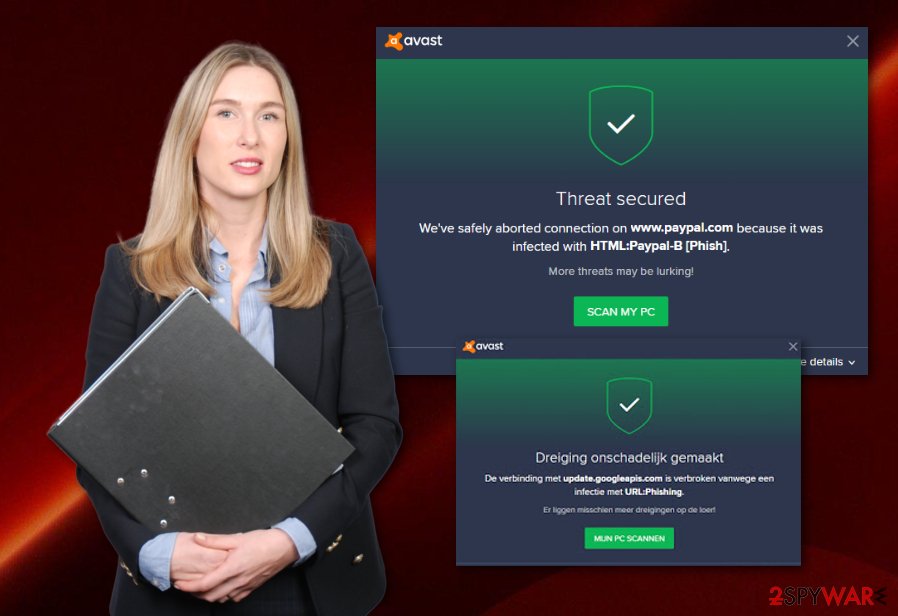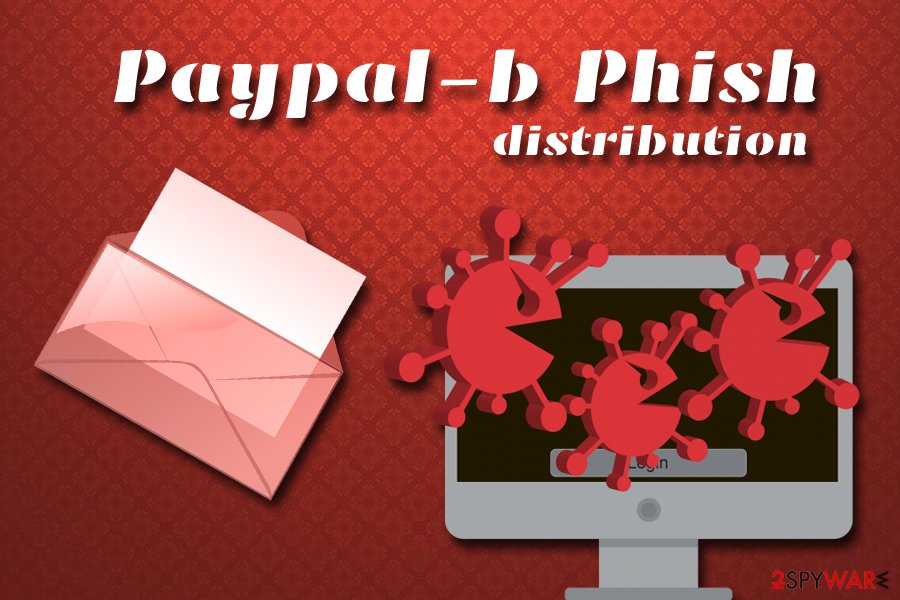Paypal-b Phish (Removal Instructions) - updated Mar 2019
Paypal-b Phish Removal Guide
What is Paypal-b Phish?
Paypal-b Phish is a well-known false positive that is related to PayPal payment service

Paypal-b Phish, also known as HTML:Paypal-B [Phish], is a detection used by AVG and Avast security applications. Many users reported about their anti-virus programs detecting the threat when they were trying to pay for an online purchase by using PayPal service, or after a full system scan. Additionally, users tried to delete browser history, cookies and browser add-ons, but the infection was still shown.[1] The anti-virus representatives concluded that the false positive[2] would be fixed, and users should update their security software to stop real PayPal service to be flagged as Paypal-b Phish. However, the definition of detection was created for a reason. Hackers might intercept the connection to PayPal or victims could potentially download malicious files that would be located in the Temp folder. Thus, if your AV engine detected a threat, you should investigate before taking any actions, as it could be related to PayPal virus.
| Name | Paypal-b Phish |
|---|---|
| Also known as | HTML:Paypal-B [Phish], PayPal virus |
| Type | Trojan horse/false positive |
| Detected by | The entry is usually used by AVG and Avast |
| OS infected | Windows |
| Distribution techniques | If it appears to be malware, such malicious content can invade the system via infected email attachments or third-party websites |
| Computer scanning tools | You can use a tool such as FortectIntego to scan the system for suspicious content and make sure it is not dangerous |
| Removal process | Eliminating the trojan is possible only by using automatic virus removal software |
If you have scanned your entire computer system and Paypal-b Phish appears to be a Trojan horse, you can experience very unpleasant effects and damage if you do not get rid of the cyber threat ASAP. Trojans are known for their ability to sneak in the computer system unnoticed and perform a variety of illegitimate and even damaging activities.
Trojan horses, including Paypal-b Phish virus, are capable of invading the system unnoticed and stealing personal data of the user which is found on the infected machine. Sadly, this type of activity might relate to identity theft as your sensitive details might be misused for some kinds of illegal purposes by the cybercriminals themselves.
Additionally, if Paypal-b Phish is indeed malware, the malicious program might serve as malware downloader, which would consequently result in more infections. The virus that is capable of downloading additional payloads is extremely dangerous, as it can be controlled by hackers remotely, and such threats like ransomware, data-stealers, or cryptominers can be uploaded to the host machine at any time.

The infection might also cause overuse of your system's resources, program struggles and crashes while trying to launch them. Also, Paypal-b Phish virus might start redirecting you to suspicious websites, that might steal your login credentials or other personal information.
Remove Paypal-b Phish virus from your Windows computer system if you are guaranteed that the infection is not a false positive. To be completely, sure, we recommend using alternative anti-malware solutions, such as FortectIntego or SpyHunter 5Combo Cleaner. This way, you will be able to see if the infection is indeed real.
However, Paypal-b Phish removal is necessary only if this application is a virus. If you have scanned the system, and the HTML:Paypal-B [Phish] detection name appeared to be a false positive note that such applications are harmless and cannot cause any damage.
Trojans can invade the system via phishing content or unsafe websites
Malware is a type of programs which install on the targeted system automatically without the user's consent. However, according to Virusai.lt experts,[3] these viruses appear on the system due to the user's carelessness while performing browsing work and other activities, e.g., opening suspicious email message attachments or clicking on links inside.
Mostly, malware such as trojans infiltrates the system through infected files such as executables which come attached to spam email messages. You need to be very careful with all the emails you receive, identify all letters that have been sent to your inbox section also. If you are not entirely sure that the content is legitimate, hurry up and remove it from your inbox.
Additionally, malware-related content might be distributed on rogue web pages or infected hyperlinks. Usually, crooks inject malicious payload to P2P networks[4] such as Torrents, eMule, or The Pirate Bay. This way users can accidentally infect their computer when trying to download a movie, game, or program downloading hyperlink.
However, Torrent viruses can be mostly avoided when using ad-blocking applications like AdBlock or AdGuard.

Paypal-b Phish automatic removal guide from Windows computer system
If you have been infected with HTML:Paypal-B [Phish] virus and anti-malware programs have alerted that this application is found as a malware-related trojan, you should take some actions to eliminate it. Remember, that the Payal-b Phish removal can be accomplished only by using robust anti-malware tools, otherwise, you might only mess all things up by trying to terminate the cyber threat on your own and leave compromised system files all over the PC.
Remove HTML:Paypal-B [Phish] virus by using only expert-tested tools. Furthermore, if you are looking for software which will help you detect the trojan and all malicious components that it has left behind, we advise leaning on programs such as FortectIntego, SpyHunter 5Combo Cleaner, or Malwarebytes. Also, check the below-given guide and reboot your computer in order to disable the activity of the Trojan horse and bring your machine back to its previous state.
Remember, Paypal-b Phish is most likely to be a false positive, but you should investigate further before you delete some vital files related to PayPal service.
Getting rid of Paypal-b Phish. Follow these steps
Manual removal using Safe Mode
Use Safe Mode with Networking to disable the Trojan horse on your computer system. Perform these instructions if help is needed:
Important! →
Manual removal guide might be too complicated for regular computer users. It requires advanced IT knowledge to be performed correctly (if vital system files are removed or damaged, it might result in full Windows compromise), and it also might take hours to complete. Therefore, we highly advise using the automatic method provided above instead.
Step 1. Access Safe Mode with Networking
Manual malware removal should be best performed in the Safe Mode environment.
Windows 7 / Vista / XP
- Click Start > Shutdown > Restart > OK.
- When your computer becomes active, start pressing F8 button (if that does not work, try F2, F12, Del, etc. – it all depends on your motherboard model) multiple times until you see the Advanced Boot Options window.
- Select Safe Mode with Networking from the list.

Windows 10 / Windows 8
- Right-click on Start button and select Settings.

- Scroll down to pick Update & Security.

- On the left side of the window, pick Recovery.
- Now scroll down to find Advanced Startup section.
- Click Restart now.

- Select Troubleshoot.

- Go to Advanced options.

- Select Startup Settings.

- Press Restart.
- Now press 5 or click 5) Enable Safe Mode with Networking.

Step 2. Shut down suspicious processes
Windows Task Manager is a useful tool that shows all the processes running in the background. If malware is running a process, you need to shut it down:
- Press Ctrl + Shift + Esc on your keyboard to open Windows Task Manager.
- Click on More details.

- Scroll down to Background processes section, and look for anything suspicious.
- Right-click and select Open file location.

- Go back to the process, right-click and pick End Task.

- Delete the contents of the malicious folder.
Step 3. Check program Startup
- Press Ctrl + Shift + Esc on your keyboard to open Windows Task Manager.
- Go to Startup tab.
- Right-click on the suspicious program and pick Disable.

Step 4. Delete virus files
Malware-related files can be found in various places within your computer. Here are instructions that could help you find them:
- Type in Disk Cleanup in Windows search and press Enter.

- Select the drive you want to clean (C: is your main drive by default and is likely to be the one that has malicious files in).
- Scroll through the Files to delete list and select the following:
Temporary Internet Files
Downloads
Recycle Bin
Temporary files - Pick Clean up system files.

- You can also look for other malicious files hidden in the following folders (type these entries in Windows Search and press Enter):
%AppData%
%LocalAppData%
%ProgramData%
%WinDir%
After you are finished, reboot the PC in normal mode.
Remove Paypal-b Phish using System Restore
Activating the System Restore feature might be a great option if you are looking for a way to deactivate malware:
-
Step 1: Reboot your computer to Safe Mode with Command Prompt
Windows 7 / Vista / XP- Click Start → Shutdown → Restart → OK.
- When your computer becomes active, start pressing F8 multiple times until you see the Advanced Boot Options window.
-
Select Command Prompt from the list

Windows 10 / Windows 8- Press the Power button at the Windows login screen. Now press and hold Shift, which is on your keyboard, and click Restart..
- Now select Troubleshoot → Advanced options → Startup Settings and finally press Restart.
-
Once your computer becomes active, select Enable Safe Mode with Command Prompt in Startup Settings window.

-
Step 2: Restore your system files and settings
-
Once the Command Prompt window shows up, enter cd restore and click Enter.

-
Now type rstrui.exe and press Enter again..

-
When a new window shows up, click Next and select your restore point that is prior the infiltration of Paypal-b Phish. After doing that, click Next.


-
Now click Yes to start system restore.

-
Once the Command Prompt window shows up, enter cd restore and click Enter.
Finally, you should always think about the protection of crypto-ransomwares. In order to protect your computer from Paypal-b Phish and other ransomwares, use a reputable anti-spyware, such as FortectIntego, SpyHunter 5Combo Cleaner or Malwarebytes
How to prevent from getting trojans
Protect your privacy – employ a VPN
There are several ways how to make your online time more private – you can access an incognito tab. However, there is no secret that even in this mode, you are tracked for advertising purposes. There is a way to add an extra layer of protection and create a completely anonymous web browsing practice with the help of Private Internet Access VPN. This software reroutes traffic through different servers, thus leaving your IP address and geolocation in disguise. Besides, it is based on a strict no-log policy, meaning that no data will be recorded, leaked, and available for both first and third parties. The combination of a secure web browser and Private Internet Access VPN will let you browse the Internet without a feeling of being spied or targeted by criminals.
No backups? No problem. Use a data recovery tool
If you wonder how data loss can occur, you should not look any further for answers – human errors, malware attacks, hardware failures, power cuts, natural disasters, or even simple negligence. In some cases, lost files are extremely important, and many straight out panic when such an unfortunate course of events happen. Due to this, you should always ensure that you prepare proper data backups on a regular basis.
If you were caught by surprise and did not have any backups to restore your files from, not everything is lost. Data Recovery Pro is one of the leading file recovery solutions you can find on the market – it is likely to restore even lost emails or data located on an external device.
- ^ Ross Padilla. HTML:Paypal-B [Phish] please help with this. AVG Support. Forums.
- ^ Starship 1. Threat Detected:- HTML:Paypal-B [Phish] . Avast. Tech forums.
- ^ Virusai.lt. Virusai.lt. Virus news and removal tips.
- ^ Bradley Mitchell. P2P Networking and P2P Software. Lifewire.com. Independent news website.







